If you are in the market for a high-performance laptop that combines sleek design with power and portability, then the ASUS Vivobook S 14 OLED (M5406) is a new ultrabook that deserves your attention. After testing it for several weeks, we found it excellent for completing tasks and a reliable work companion. What's more, its standout feature, an incredible OLED display, takes at-home entertainment to new luxurious heights.
ASUS, known for producing top-notch gaming laptops, has made bold claims with its new Vivobook S 14 OLED. While not a gaming laptop, it's part of the Vivobook series: thin, powerful, and long-lasting ultra-books designed for daily use. With the S 14 OLED, ASUS promises a next-level AI experience, a slim and lightweight design, minimalist aesthetics, powerful performance, thermal technology, and a long-lasting, fast-charging battery. Our tech writer and reviewer, Harvey Isitt, spent several weeks with ASUS' new laptop to see if it lives up to all that it promises.
The quick version
The ASUS Vivobook S 14 OLED impresses with its sleek, all-metal design and high-end internals. Its OLED display offers vibrant colours and deep blacks, though its 60Hz refresh rate and glossy glare-prone finish may be drawbacks for some. With excellent battery life, lasting up to 15.5 hours, it's perfect for long work sessions or cross-country travel.
Despite some fan noise and warmth when pushed, the laptop remains cool and quiet during everyday use. The keyboard is comfortable and features an RGB backlight, the touchpad is responsive, and the port selection is robust.
The laptop’s durability is underscored by its MIL-STD-810H rating, making it a reliable companion for on-the-go use. However, it’s a fingerprint magnet and lacks higher resolution or refresh rate options. Overall, the ASUS Vivobook S 14 OLED offers a superb balance of performance, portability, and value.
box.co.uk
Pros
- Vibrant and colour-accurate 14-inch OLED HDR display
- Impressive battery performance
- Sleek and lightweight, with long-lasting all-metal construction
Cons
- Fingerprint-prone and glossy display causes glare
| CPU | AMD Ryzen™ 7 8845HS 8 Core-Processor |
| GPU | AMD Radeon™ Graphics |
| RAM | 16GB LPDDR5X |
| Storage | 512GB M.2 NVMe™ PCIe® 4.0 SSD |
| Display | 14 in WUXGA OLED 100% DCI-P3 Screen, 2880 x 1800, 3.8 GHz |
| Battery Life | 75Wh, up to 15.5 hours |
| Dimensions | 360 x 1990 x 2350 mm |
| Weight | 1.32kg (1.67kg with charger) |
| Ports | HDMI 2.1, USB-C Thunderbolt x 2, microSD, USB-A, 3.5mm Jack |
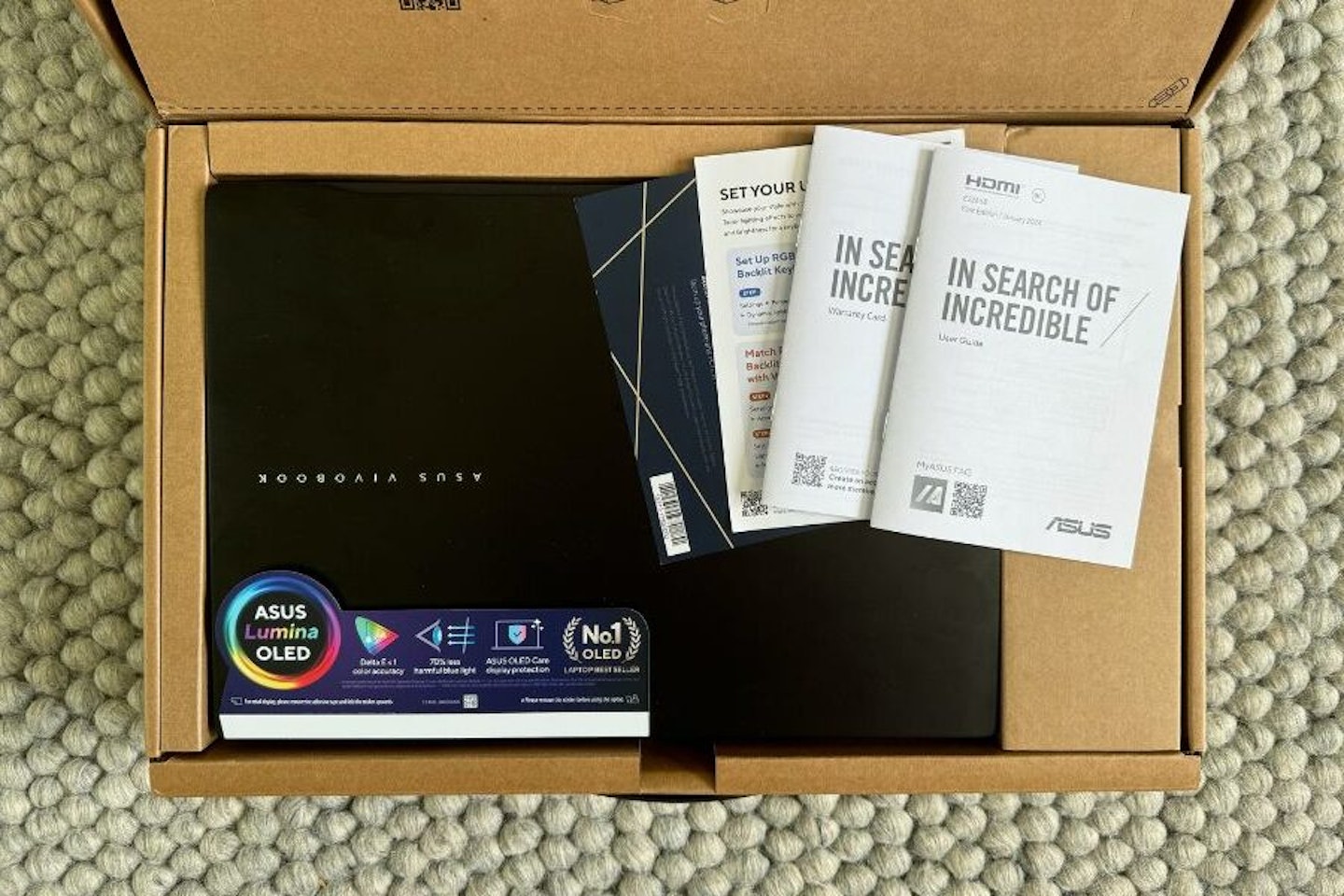
Build
When it comes to the design, the Vivobook comes in an efficiently packaged, environmentally-friendly box made of 95 per cent recycled paper. You'll find the unit itself in a protective outer inside the box. Underneath you'll find accompanying documents, including a user guide and warranty card. Alongside the laptop, you receive a compact 90W power charger with a USB-C connection and power cable. Additionally, the packaging doubles as a laptop stand.
Fingerprints
As soon as I took the unit out of the box, I noticed its all-metal exterior, while sleek and luxurious, easily attracts fingerprints. I have the black version, which is especially prone to fingerprints, although a grey option is also available. Investing in cleaning cloth is advisable, though it will – and did – get old fast, and the frustration soon set in. I constantly had to wipe it with a special cleaning cloth during testing, eventually giving up. As a result, the unit is absolutely covered. This will be frustrating for some users, so it's something to be aware of.
The laptop weighs 1.32 kg (1.67 kg with the charger), making it ideal for carrying to and from work. The keyboard has effortless travel, and the font is sleek, large, and accessible, making it comfortable and user-friendly. It has a great precision touchpad much larger than previous models, which is nice to see. The chassis is MIL-STD-810H rated, so it's pretty durable for build quality. The same can be said for the screen's flexibility, and the display opens with ease.
Privacy Shutter
A privacy shutter is also on the top of the screen for webcam security and privacy. Unfortunately, I found this to be jammed on first use. I had to push it quite hard for its stubbornness to give, and after about ten or so tries, it feels less rigid, though it still isn't as smooth as I would have liked. I am sure, however, that this is a hiccup with my individual unit rather than a design fault.
You can also push the screen back 180 degrees, a nice feature, though I have yet to figure out why I might need this. Even so, the hinges are pretty good and don't produce noticeable wobbles while typing. So, overall, an impressive build despite the fingerprint frenzy.
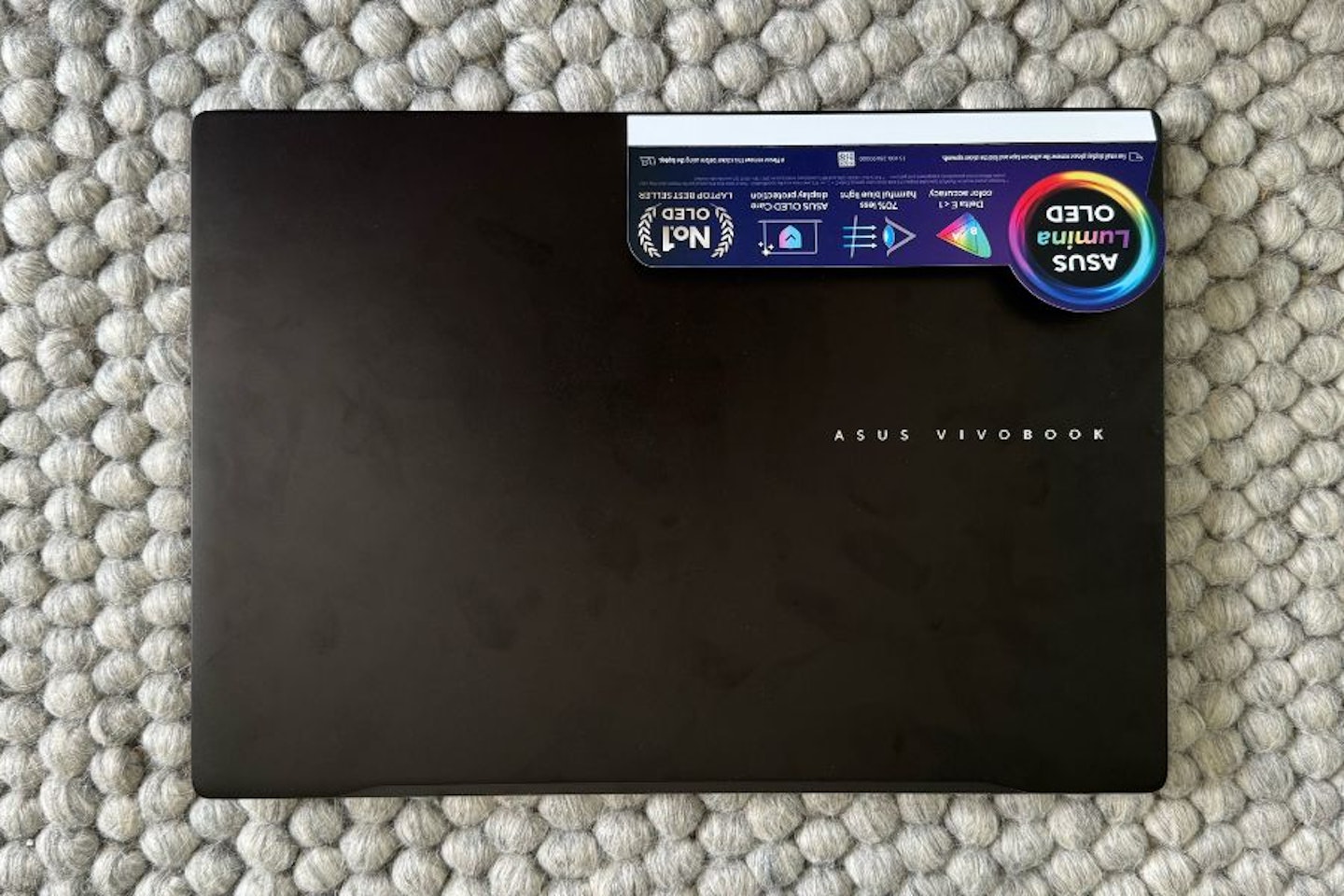
Usability
The laptop's build quality and features make it easy and enjoyable, with the well-designed keyboard, touchpad, and port selection allowing for comfortable and efficient interaction.
Keyboard
The keyboard is similar in style to the Zenbook's chicklet keys, with well-spaced, appropriately-sized keys featuring a sleek, easily accessible font that I particularly appreciate. It offers a generous 1.7 millimetres of key travel, making writing long documents, emails, and, no less, this article a breeze.
One of the most surprising features of the device is its single-zone RGB backlit keyboard, which allows for customised colours in the settings. This feature is typically found in gaming laptops, but since ASUS is one of the top gaming laptop brands – just look at the ASUS ROG Zephyrus G16 we recently reviewed, for example – it's not unexpected that they would include it in an everyday ultrabook. It's a way to add some colour to late-night writing with three choices: solid colour, breathing animation, and rainbow animation in white, light blue, blue, purple, pink, orange, yellow, and green. However, it can be a bit difficult to see the colours against the keys in lighter conditions – so it's important to note that they are not as bright as the backlighting on your typical gaming laptop.
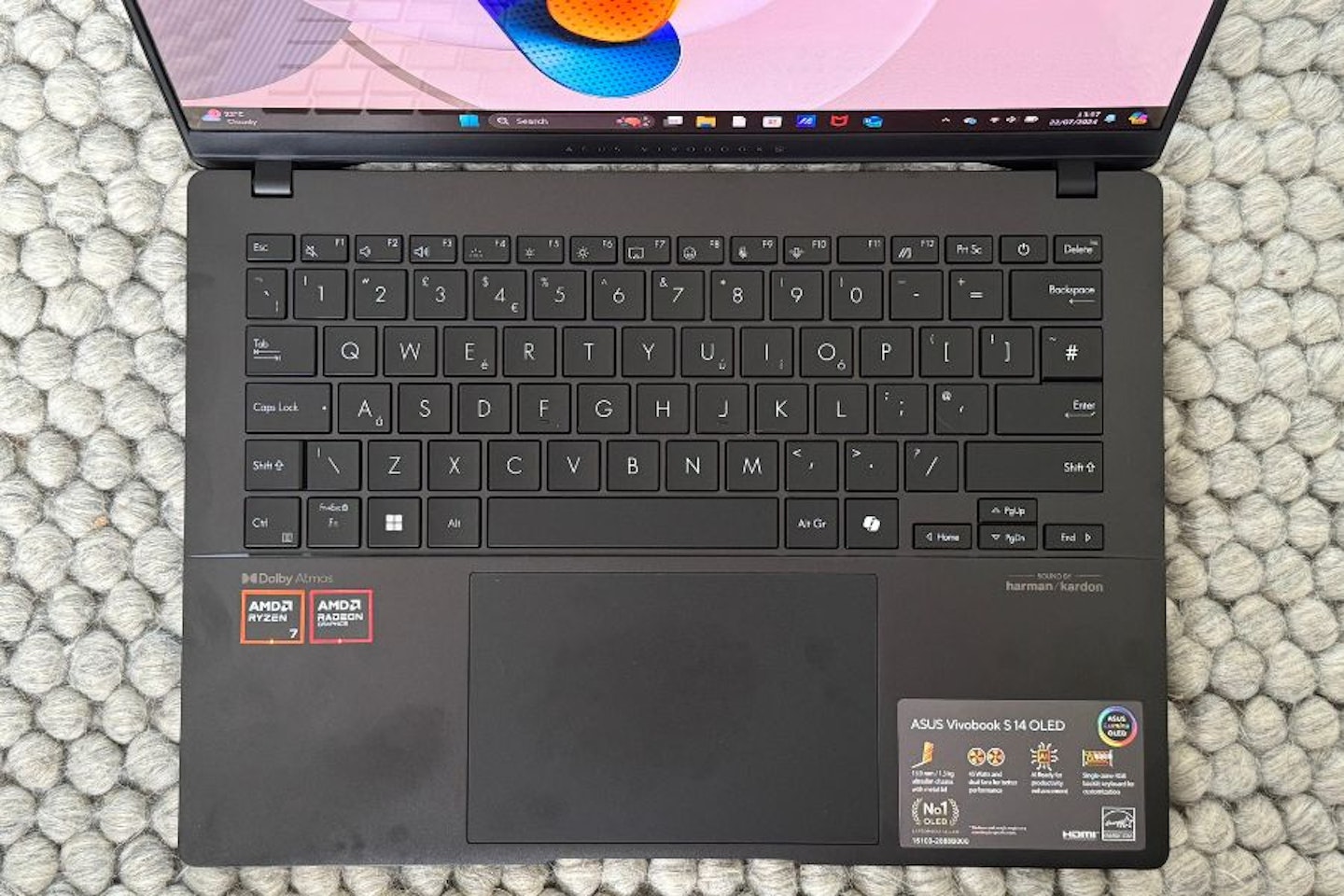
Touchpad
The Vivobook also boasts a spacious precision touchpad that is 40 per cent larger than its previous iteration. This touchpad is impressively responsive with almost no cursor lag and supports various one- or two-finger gestures for more straightforward navigation. It might take some time to get used to, but it allows for convenient control to adjust audio, screen brightness, and video playback. And, like most laptops, the touchpad allows scrolling through documents and zooming in and out using standard touch gestures.
In line with modern technology, the keyboard also features an AI co-pilot key positioned two keys to the right of the space bar. ASUS claims this key significantly enhances the user experience. Read on to find out if this is the case.
Ports
The availability of ports is a crucial aspect of a laptop's usability. The Vivobook offers a good selection, with an HDMI 2.1 TMDS port, two USB-C Thunderbolt ports, a micro SD card reader, a 3.5mm microphone headphone jack on the left side, and two USB-A 3.2 Gen One ports on the right side. I found this selection to be near-perfect. However, I would prefer a full-sized SD card slot for transferring larger files from my camera to my laptop for video editing.
Another change would be to distribute the two USB-C ports across both sides. As of now, if I connect my multiport adapter, the other USB-C port becomes unusable for tasks like charging the laptop simultaneously. Nevertheless, I could easily resolve this issue by investing in a Type-C USB docking station with a greater cable length, but I felt it worth mentioning.
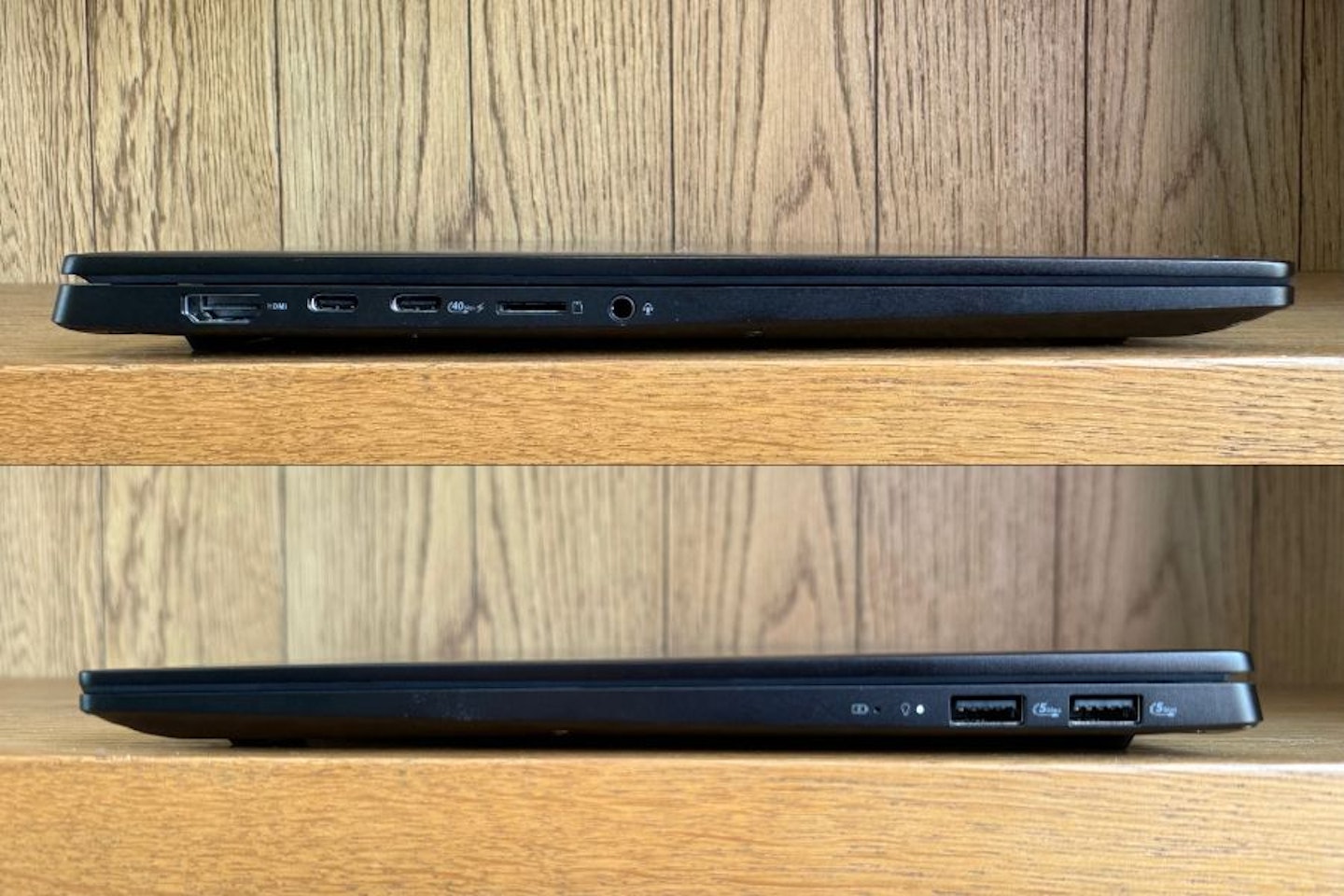
Display
The Vivobook's standout feature is undeniably its OLED display. Despite offering only a 60Hz refresh rate, having an OLED display on an everyday laptop brings a whole new experience for navigating documents, photos, and especially video content. Revisiting some classic movies with this display was an absolute pleasure. It brought a whole new level to my viewing experience: deep blacks, excellent white point, vibrant colour accuracy, and high contrast. The impressive 600 nit peak brightness also made for easy viewing in pretty much any lighting condition. That said, the glossy screen sometimes causes glare and reflections, so keep this in mind when using the device during the day. Nothing a quick close of a curtain or reposition away from a window can't solve!
Some people, such as myself, may experience screen flickering on the OLED display when the brightness is below 50 per cent (caused by pulse width modulation, or PWM, to control brightness). While many won't notice this, those who are sensitive should be aware. The same can be said for screen burning, where a visible mark is left on the display after a fixed image has been on the screen for a long time. OLED displays are especially susceptible to this.
On the bright side, ASUS is known for providing reliable and frequent software updates, and its Vivobook S 14 is no exception. This laptop includes ASUS OLED Care, which offers optimisation settings to protect the display and prolong its lifespan. It also has a Pixel refresh feature that launches a unique screen saver after 30 minutes of idle time to refresh the screen pixels and optimise picture quality. We recommend keeping the latter feature enabled.
Webcam, mics, AI effects
The Vivobook has a built-in 1080p IR camera with a privacy shutter, allowing for swift log-in via facial recognition. The AI features of the webcam include an auto-framing function that tracks and keeps your face within the frame during video calls, along with standard background and portrait blur effects. While the video and audio quality is better than most standard laptops, its mic capture sounds quite tinny compared to most smartphones on the market.
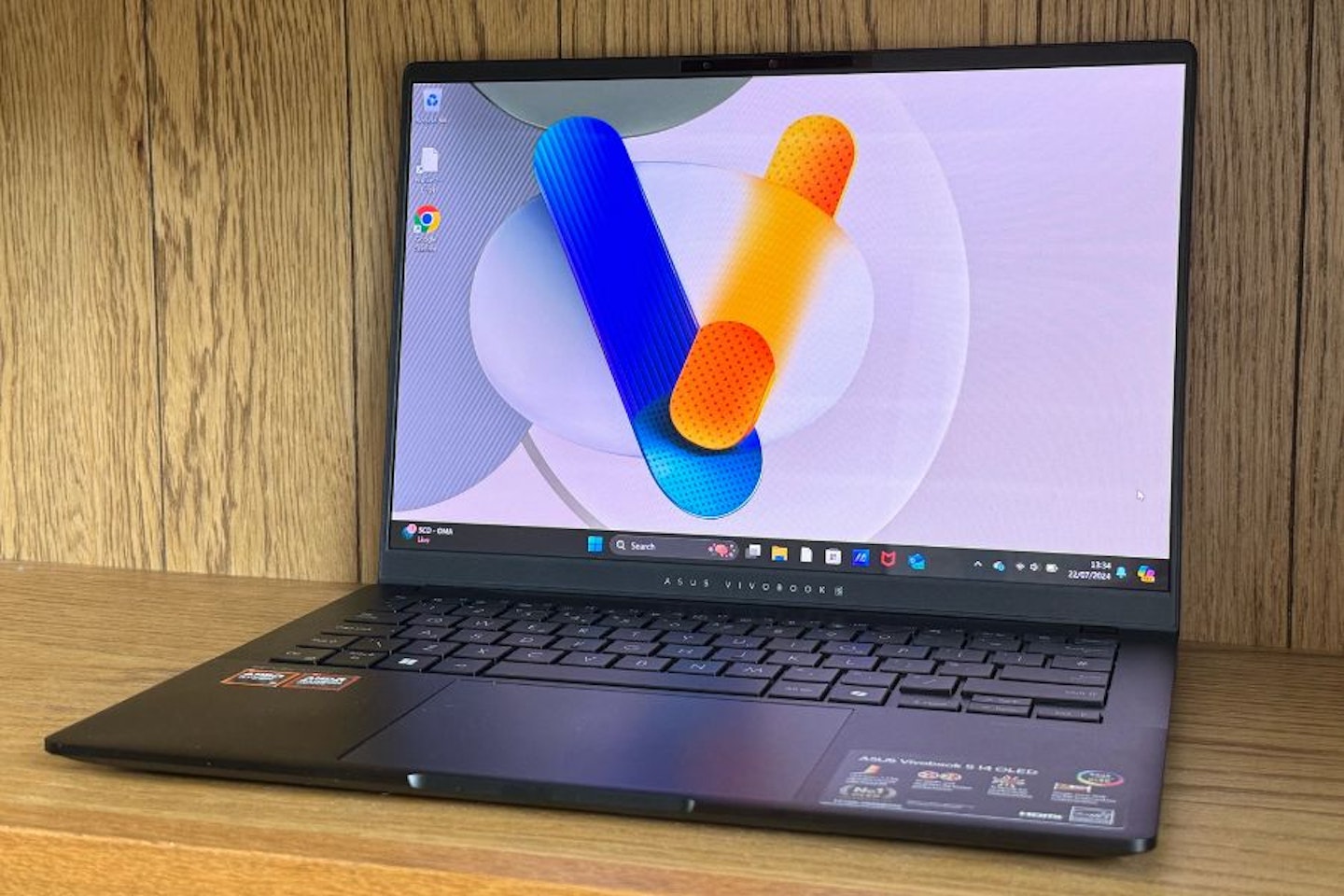
Performance
With its sleek and lightweight build, the Vivobook S14 excels as an everyday laptop. The keyboard is comfortable for extended work sessions, and handling multiple tabs on Chrome and Edge is not an issue. The laptop sufficiently handles multitasking, supporting tasks like watching Netflix while having additional tabs open for YouTube, Google Docs, and other tech-related pages, all without major performance issues. It's worth noting that this laptop isn't designed for heavy gaming use.
Audio & sound
Although the bottom-firing speakers with Dolby Atmos from Karman Kardon provide good volume, decent bass, and mids, they do not compete with the likes of my MacBook Air. However, they are more than adequate for video calling and entertainment. However, when watching Netflix and YouTube, I often found myself connecting my Apple AirPods to the device instead of using the built-in speaker. This was due to personal preference rather than a lack of quality with the speakers.
Battery
With the same battery as the more expensive Zenbook 14 OLED, this device offers 15.5 hours of battery life, compared to its previous iteration's 12.5 hours. This laptop will last through a cross-country flight or for extended work or leisure use throughout the day. However, when under load - for this, I ran Teams, Spotify, Edge, and a movie on Netflix - the battery life lasted for around seven and a half hours.

Thermals and fan noise
The dual fans and titanium build help keep the device cool during regular use. While there was some warmth under the keyboard when running multiple applications and streaming, the fan noise was mostly unnoticeable. However, during demanding tasks like watching Netflix with numerous additional tabs open, the fan noise became much more noticeable like you would expect of most laptops of this price range.
Copilot
ASUS has pushed the Copilot key as a standout feature in advertising the Vivobook S 14 OLED, offering instant one-touch access to AI capabilities. I was particularly excited to try this out but disappointed when I did. The Copilot feature doesn't offer anything new. Don't get me wrong, the image generator and text-based prompt tool were enjoyable to use but were by no means impressive. There are already plenty of similar tools available online. However, having easy access to these features does make for a more seamless experience. It's just unfortunate that you have to pay for extra credits to use the image generator.
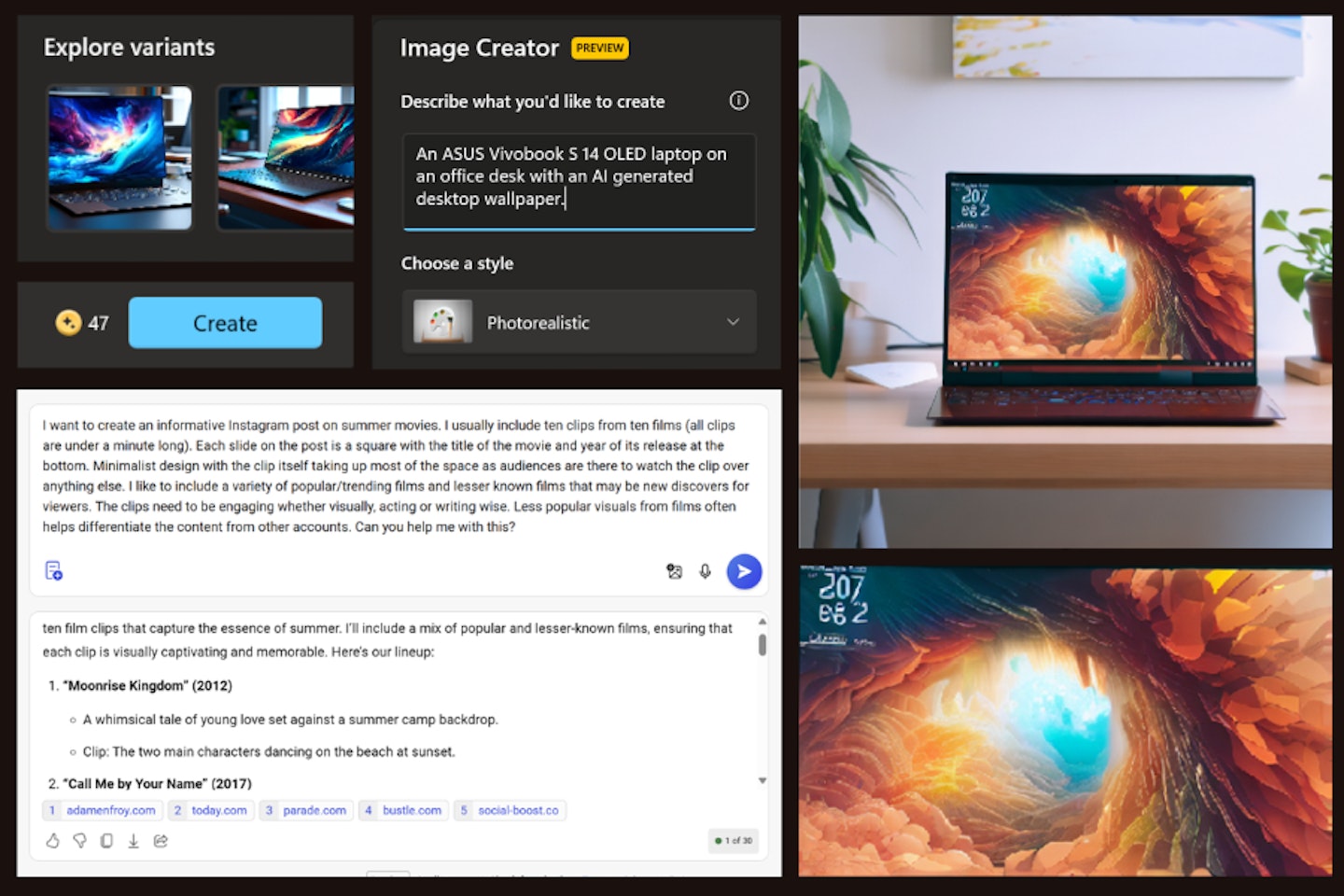
Price and Competition
Priced at £1,099.99, the ASUS Vivobook S 14 OLED offers exceptional value with its top-notch features and performance. Its stunning OLED display, powerful processor, and robust construction set it apart from similar laptops. Although the Zenbook 14 OLED, priced slightly higher at £1299.00, provides a touchscreen for a more immersive experience, the Vivobook S 14 OLED still shines. On the other hand, the Zenbook DUO OLED, at a significantly higher price of £1897.00, offers a dual screen, providing a game-changing increase in screen real estate. You can find reviews for both of these laptops below. However, despite the competition, the Vivobook S 14 OLED remains an excellent choice.
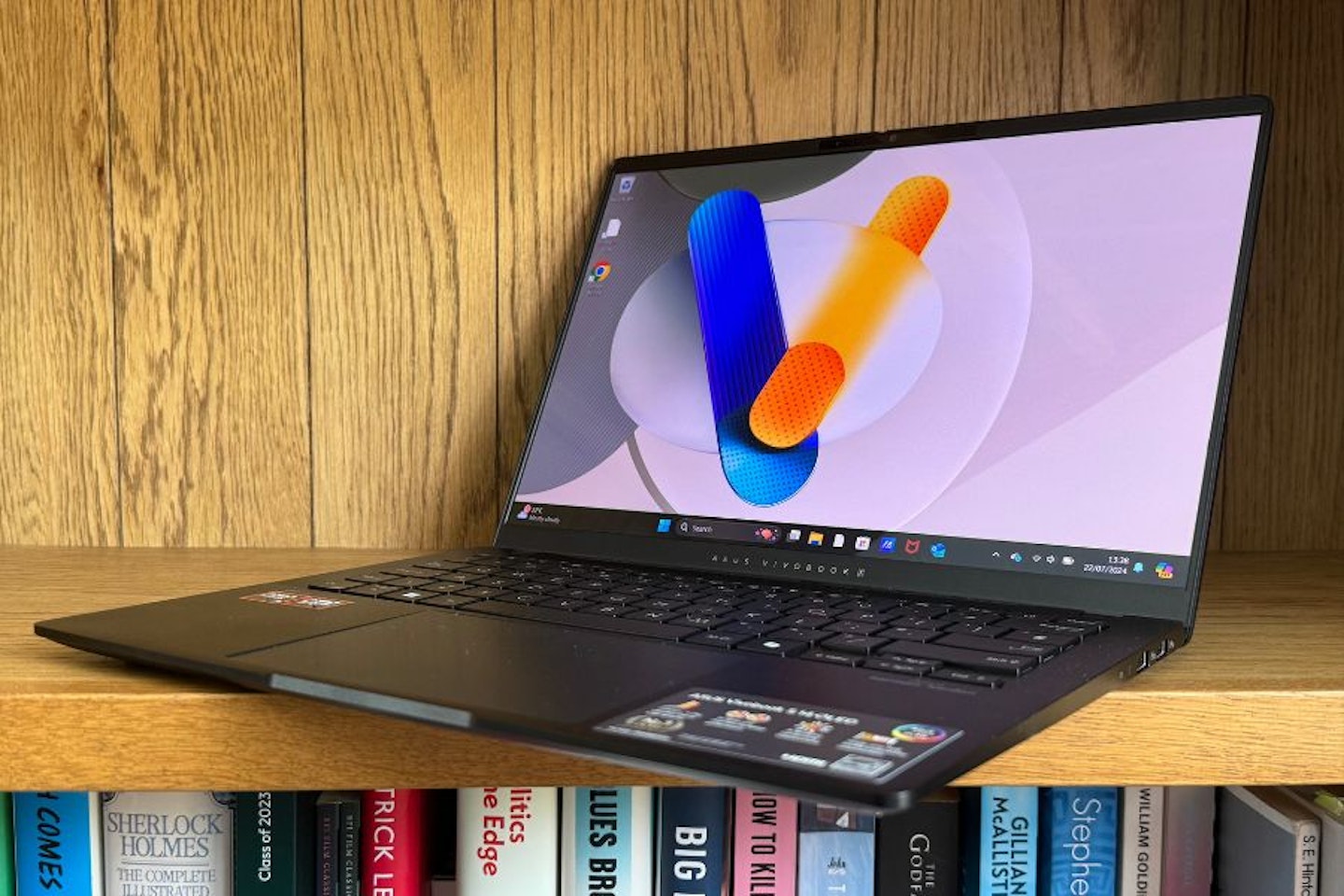
Final thoughts
The ASUS Vivobook S 14 OLED is an tempting option for those seeking a high-performance laptop that balances sleek design with affordability. Its OLED display offers vibrant colours and deep blacks, enhancing the at-home entertainment experience. The laptop's long-lasting battery life of up to 15.5 hours and durable build make it an ideal companion for long work sessions or on-the-go use. The comfortable keyboard, responsive touchpad, and robust port selection contribute to an overall user-friendly experience.
Having said that, the laptop does have drawbacks. The all-metal exterior easily attracts fingerprints, making maintenance a hassle. The 60Hz refresh rate and glossy glare-prone finish of the OLED display may not suit all users. Likewise, some users may find the fan noise and warmth produced by the laptop noticeable under heavy usage and the Copilot key underwhelming.
Despite these drawbacks, the ASUS Vivobook S 14 OLED still manages to offer a superb balance of performance, portability, and value. It's a worthwhile purchase for those in need of a reliable and efficient work companion and who prioritise performance and portability in a stylish, well-built design. However, for anyone looking for a gaming laptop should look elsewhere.
More items to consider
The ASUS Zenbook 14 OLED is a powerful laptop with impressive features and a sleek design. It has a vibrant OLED touchscreen and Dolby Atmos sound and comes with an ASUS Pen, making it suitable for entertainment and creative work. The laptop's Intel i7 processor, 32 GB of RAM, and 1TB SSD provide excellent performance, although its gaming capabilities are limited. The device is durable, has a respectable battery life, and stays cool and quiet under load. It's recommended for those seeking a portable entertainment and creative workstation.
If you want more information about the ASUS Zenbook 14 OLED, check out our Senior Tech Writer Chris Duffill's review, which you can find here.
Pros
- OLED display and Dolby Atmos sound make it excellent for entertainment
- Intel i7 processor, 32 GB of RAM, and a 1TB SSD for excellent performance
- ASUS Pen and touchscreen support creative work
Cons
- Glossy screen can reflect light, affecting viewing experience in certain lighting conditions
| CPU | Intel Core Ultra 7 Processor 155H 3.8GHz |
| GPU | Intel Arc Graphics (Intel Arc 8-Cores iGPU - ID 7D55) |
| RAM | 32GB |
| Storage | 1TB M.2 NVMe SSD |
| Display | 2880 x 1800 pixels, 14.0-inch OLED touchscreen |
| Battery Life | Approx 8 hours |
| Dimensions | 312.4 x 220.1 x 14.9 ~ 14.9 mm |
| Weight | 1.28kg |
The ASUS Zenbook DUO OLED laptop offers two full-size screens built into a 14-inch laptop, providing excellent power and portability. With a 32GB RAM, 2TB SSD, and Intel Ultra 9 processor, it's a powerful alternative to a desktop PC. The dual-screen setup is especially useful for multitasking, creative work, and media consumption, and the touchscreen gestures and customisable workspaces enhance productivity. The laptop's build quality, backlit keyboard, and touchpad add to its appeal. However, battery life is limited in dual-screen mode. It's a versatile and powerful device suitable for business and creative users.
For more information about the ASUS Zenbook DUO OLED, head over to our Senior Tech Writer Chris Duffill's review here.
Pros
- Impressive power with Intel Ultra 9 processor, 32GB of RAM, and 2TB solid-state drive
- Dual-screen setup for an expansive and versatile workspace, perfect for multitasking, creative work, and entertainment
- Considered touchscreen gestures and sturdy built-in stand for enhanced productivity
Cons
- Significantly reduced battery life when in dual-screen mode
| CPU | Intel Core Ultra 9 Processor 185H 2500Mhz, 16 cores, 22 Threads |
| GPU | Intel Arc Graphics |
| RAM | 32GB |
| Storage | 2TB M.2 NVMe PCIe 4.0 SSD |
| Display | Two 14.0-inch touchscreens, 2.8K (2880 x 1800) OLED 16:10 aspect ratio, 400nits peak brightness, 100% DCI-P3 color gamut, DisplayHDR |
| Battery Life | 75WHrs (around 6 hours under average use with one screen) |
| Dimensions | 313 x 217 x 14.6 ~ 19.9 mm |
| Weight | 1.66kg (with keyboard) |
The 2024 Apple MacBook Air offers a sleek design, powerful performance with an Apple M3 chip, and a stunning 500-nit 2560 x 1600p Liquid Retina display. Weighing 1.24kg, it provides an optimal user experience, and the 18-hour battery life ensures uninterrupted use. While not the most powerful laptop on the market, its lightweight design, excellent macOS, and premium metal chassis make it one of the most pleasant laptops, ideal for long office hours.
Pros
- Impressive Apple M3 chip with 33 per cent more memory bandwidth than their M2 chip
- Razor-thin 1.24kg build design with a sleek metal chassis
- Impressive speakers and stunning screen resolution
Cons
- Some users may find the RAM underwhelming
| CPU | Apple M3 Chip, 8-core |
| GPU | Apple M3 Chip, 10-core |
| RAM | 8GB |
| Storage | 256GB SSD or 512 GB |
| Display | 13.6-inch (diagonal) LED-backlit display (2560 x 1664) native resolution at 224 pixels per inch with support for 1 billion colors, 500 nits brightness |
| Battery Life | 18 hours |
| Dimensions | 304 x 215 x 113 mm |
| Weight | 1.24kg |
Who tested it?
Tech Writer and Reviewer Harvey Isitt tested the ASUS Vivobook S 14 OLED. He is a seasoned tech enthusiast with extensive experience testing and reviewing consumer electronics. His insights are based on thorough hands-on testing and in-depth analysis.
How we tested it
The ASUS Vivobook S 14 OLED was tested over several weeks. It was used for daily tasks, including work, personal use, writing this article, multimedia consumption, and entertainment viewing through the laptop's built-in speakers and via Bluetooth connectivity.
Why should you trust us?
At What’s The Best, our mission is to provide accurate and reliable reviews, ensuring our readers receive honest and transparent information about the best technology products available. Anything less would undermine our commitment to being a trusted source of unbiased product information.
Our dedicated in-house writing team comprises experts with extensive experience and a genuine passion for technology. Collectively, we have spent decades testing and writing about tech, leveraging our expertise in all our articles, advice pieces and reviews.
We maintain complete editorial independence and do not accept payment for product reviews. Our writers have full control over their content, ensuring that products are selected based solely on the needs of our readers. While we may earn commissions or other compensation from links on our website, this never affects our product choices. These links enable us to continue offering valuable consumer advice, without compromising the integrity of our reviews.
How What's The Best test products
Real people, real reviews and trusted buying advice.
Tired of confusing tech reviews? At What's The Best, we cut through the jargon with down-to-earth product evaluations. Our team of experienced reviewers puts everyday gadgets to the test, using them just like you would. We don't waste time on unrealistic scenarios; instead, we focus on real-world performance that matters to consumers.
This means unbiased buying advice you can trust. We only review significant and relevant products, so you can be sure you're getting the latest insights. Haven't seen a review for what you're looking for? Don't worry—we're constantly adding new products to our growing catalogue.
For in-depth details on our testing process, visit our dedicated tech and electronics how we test page.
Harvey Isitt is a Tech Writer and Reviewer for What's the Best. Harvey writes reviews, buyers and how-to guides, and listicles on a broad range of topics.
Besides writing, Harvey is an avid camera, turntable, and speaker enthusiast with a somewhat unhealthy obsession with movies. He is also a keen runner, cyclist, hiker, and swimmer.
Subscribe to the What's The Best Newsletter to keep up to date with more of the latest reviews and recommendations from the What's The Best team.


























